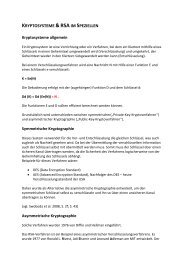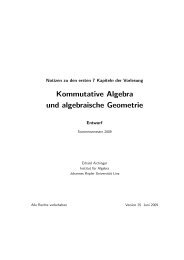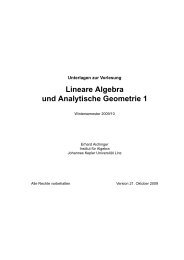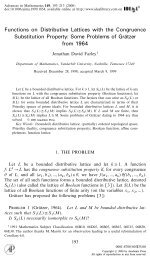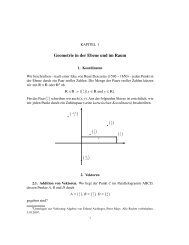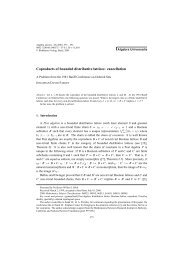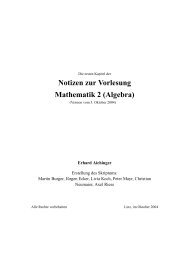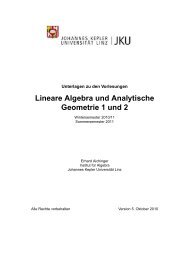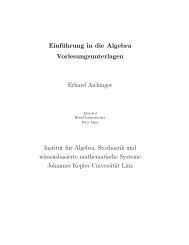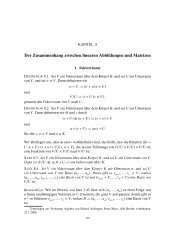SHARPLY 2-TRANSITIVE GROUPS WITH POINT STABILIZER OF ...
SHARPLY 2-TRANSITIVE GROUPS WITH POINT STABILIZER OF ...
SHARPLY 2-TRANSITIVE GROUPS WITH POINT STABILIZER OF ...
You also want an ePaper? Increase the reach of your titles
YUMPU automatically turns print PDFs into web optimized ePapers that Google loves.
PROCEEDINGS <strong>OF</strong> THE<br />
AMERICAN MATHEMATICAL SOCIETY<br />
Volume 134, Number 1, Pages 9–13<br />
S 0002-9939(05)08272-9<br />
Article electronically published on August 15, 2005<br />
<strong>SHARPLY</strong> 2-<strong>TRANSITIVE</strong> <strong>GROUPS</strong> <strong>WITH</strong> <strong>POINT</strong> <strong>STABILIZER</strong><br />
<strong>OF</strong> EXPONENT 3 OR 6<br />
PETER MAYR<br />
(Communicated by Jonathan I. Hall)<br />
Abstract. Using the fact that all groups of exponent 3 are nilpotent, we show<br />
that every sharply 2-transitive permutation group whose point stabilizer has<br />
exponent 3 or 6 is finite.<br />
1. Introduction<br />
Let G be a sharply 2-transitive permutation group acting on a (possibly infinite)<br />
set Ω, that is, G is 2-transitive on Ω, |Ω| > 1, and only the identity of G fixes more<br />
than one element in Ω.<br />
It is still unknown whether an infinite sharply 2-transitive group G always has a<br />
normal subgroup that is regular (i.e. sharply 1-transitive on Ω) as in the finite case.<br />
Kerby gave an affirmative answer to that question under the assumption that for<br />
some α ∈ Ω every conjugacy class in the point stabilizer H := {g ∈ G | g(α) =α}<br />
is finite [2, Theorem 9.6]. Suchkov showed that if H is a 2-group, then G has a<br />
regular normal subgroup and G is in fact finite [5]. However it is not known whether<br />
a sharply 2-transitive group with point stabilizer of finite exponent is necessarily<br />
finite. In this note we prove the following:<br />
Theorem 1.1. Let G be a sharply 2-transitive permutation group on Ω, andletH<br />
be the stabilizer in G of a point α ∈ Ω. Then we have:<br />
(1) If exp H =3,then|G| =12.<br />
(2) If exp H =6,then|G| =42.<br />
Consequently every sharply 2-transitive group G with point stabilizer of exponent<br />
3 or 6 has a regular normal subgroup. In fact G is the group of linear functions on<br />
the field of order 4 or 7, respectively.<br />
As a further consequence of Theorem 1.1, every near-field with multiplicative<br />
group of exponent 3 or 6 is a finite field. We note that every zero-symmetric nearring<br />
with 1, whose elements satisfy x n = x for a fixed integer n>1, is a subdirect<br />
product of near-fields satisfying the same equation (cf. [3] or the corresponding<br />
result for rings by Jacobson [1]). Hence, by Theorem 1.1, every zero-symmetric<br />
near-ring with 1 that satisfies x 7 = x is a subdirect product of finite fields. In<br />
Received by the editors July 21, 2004.<br />
2000 Mathematics Subject Classification. Primary 20B20; Secondary 20B22.<br />
Key words and phrases. (Infinite) sharply 2-transitive groups.<br />
This work was supported by grant P15691 of the Austrian National Science Foundation (FWF)<br />
and was obtained during the author’s visit at UW Madison, Wisconsin.<br />
9<br />
c○2005 American Mathematical Society<br />
Reverts to public domain 28 years from publication
10 PETER MAYR<br />
particular both addition and multiplication are commutative operations for such a<br />
near-ring.<br />
2. Auxiliary results<br />
Following the exposition in [5] we state the basic results on sharply 2-transitive<br />
groups, which we will need to prove Theorem 1.1.<br />
Throughout this section we use the following conventions. Let G be a sharply<br />
2-transitive group on a set Ω. We fix α, β ∈ Ω,α ≠ β, and we fix the stabilizer of<br />
α, H := {g ∈ G | g(α) =α}. Since G is sharply 2-transitive, we have a uniquely<br />
determined element i ∈ G such that i(α) =β and i(β) =α. Wenotethati is an<br />
involution in G \ H.<br />
Lemma 2.1 ([5, 1.1]). For all g ∈ G \ H, there are uniquely determined elements<br />
a, b ∈ H such that g = aib.<br />
Lemma 2.2 ([5, 1.2]). All involutions in G \ H are of the form i a for some a ∈ H,<br />
and all involutions in G are conjugate in G.<br />
Lemma 2.3 ([5, 1.3]). There is at most one involution in H.<br />
We call an element g ∈ G regular if g(γ) ≠ γ for all γ ∈ Ω.<br />
Lemma 2.4 ([5, 1.9]). Every product of 2 distinct involutions in G is regular.<br />
Lemma 2.5. Every non-trivial element in G that commutes with a regular element<br />
is regular.<br />
Proof. Let g ∈ G be regular. Let a ∈ G be such that a commutes with g and a<br />
fixes some γ ∈ Ω. Then a = a g stabilizes γ and g −1 (γ) ≠ γ. Thusa =1. □<br />
Lemma 2.6. Let j ∈ H be an involution. If H is torsion, then ij has finite order.<br />
Proof. Since j i ∉ H, we have a ∈ H such that j i = i a by Lemma 2.2. By<br />
Lemma 2.3, j is central in H. Hence (ij) a = i a j = j i j =(ij) 2 . Let m denote<br />
the order of a. Thenij =(ij) am =(ij) 2m . The order of ij divides 2 m − 1. □<br />
Let ¯H := H \{x ∈ H | x 2 =1}. By Lemma 2.1, we may define functions<br />
ϕ, ψ : ¯H → H by<br />
ϕ(x) :=yz and ψ(x) :=zy,<br />
where y, z ∈ H are such that x i = yiz. From Lemmas 2.2, 2.3, and 2.4, we obtain<br />
that ϕ( ¯H) ⊆ ¯H and ψ( ¯H) ⊆ ¯H.<br />
Lemma 2.7 ([5, 1.4]). We have ϕ(ϕ(x)) = x for all x ∈ ¯H.<br />
Proof. Let x ∈ ¯H, andlety, z ∈ H be such that x i = yiz. Now y i = xiz −1 and<br />
z i = y −1 ix yield (yz) i = xiz −1 y −1 ix. Hence x −1 (yz) i is an involution, and it is<br />
not contained in H. By Lemma 2.2, we have a ∈ H such that x −1 (yz) i = i a .Then<br />
(yz) i = xa −1 ia yields ϕ(ϕ(x)) = ϕ(yz) =x.<br />
□<br />
Lemma 2.8 ([5, 1.8]). The map ψ : ¯H → ¯H is injective.<br />
Proof. Let x, r ∈ ¯H, andlety, z, s, t ∈ H be such that x i = yiz and r i = sit.<br />
We assume that zy = ts. Then x iz−1 = zyi = tsi = r it−1 and, consequently,<br />
x iz−1ti = r. Since α is the unique fixed point of r, wehave(iz −1 ti) −1 (α) =α.<br />
Now iz −1 ti stabilizes both α and i(α). Hence z = t. Thus we obtain y = s and<br />
x = r.<br />
□
<strong>SHARPLY</strong> 2-<strong>TRANSITIVE</strong> <strong>GROUPS</strong> 11<br />
Lemma 2.9. Let C be a finite conjugacy class in H with C ⊆ ¯H. Then C =<br />
ψ(ϕ(C)).<br />
Proof. We note that ϕ(x) andψ(x) are conjugate in H for all x ∈ ¯H. Since<br />
ϕ(ϕ(C)) = C by Lemma 2.7, we then have ψ(ϕ(C)) ⊆ C. Equality follows from<br />
Lemma 2.8 since C is finite and ϕ is bijective.<br />
□<br />
3. Proof of the theorem<br />
For proving Theorem 1.1, we will need the following fact, whose proof may be<br />
found in [4].<br />
Lemma 3.1 ([4, cf. 12.3.5, 12.3.6]). All groups of exponent 3 are nilpotent.<br />
Proof of Theorem 1.1(1). We use the notation of the previous section. Let G be<br />
a sharply 2-transitive group with exp H = 3. We will see that the finiteness of H<br />
follows from Lemma 3.1 once we have shown:<br />
(3.1) Every finite normal subgroup of H has order at most 3.<br />
Let ¯H := H \{1}. First we show<br />
(3.2) i · i a = i a2 for all a ∈ ψ( ¯H).<br />
Let x ∈ ¯H, andlety, z ∈ H be such that x i = yiz. The order of x iz−1 = zyi is 3.<br />
For a := zy, wehave1=(ai) 3 =(aia 2 )(a −1 ia)i. Bya = a −2 , this yields (3.2).<br />
For proving (3.1), we let U be a finite normal subgroup of H with U ≠ {1}. We<br />
claim that<br />
(3.3) K := {i u | u ∈ U}∪{1} is an elementary abelian 2-group.<br />
It suffices to show that the product of any 2 distinct involutions in K is contained<br />
in K. Since U is finite and normal in H, all elements of U have finite conjugacy<br />
classes in H. Hence U \{1} ⊆ψ( ¯H) by Lemma 2.9. For u, v ∈ U, u ≠ v, wehave<br />
i u · i v =(i · i vu−1 ) u =(i vu−1 vu −1 ) u = i vu−1v ∈ K, where we used (3.2) for a = vu −1 .<br />
Thus K is a group. Since exp K =2,wealsohavethatK is elementary abelian.<br />
We note that i u ≠ i v for all u, v ∈ U, u ≠ v, by Lemma 2.1. Thus<br />
|K| = |U| +1and|K| =2 n<br />
for some number n. Since U is a subgroup of H, wehavethat|U| =2 n − 1is<br />
a power of 3. We note that 3 divides 2 n − 1 if and only if n is even. Hence<br />
2 n − 1=(2 n/2 − 1)(2 n/2 + 1). Both 2 n/2 − 1and2 n/2 +1 are powers of 3. This<br />
implies n = 2 and proves (3.1).<br />
By Lemma 3.1, we have that H is nilpotent and hence |Z(H)| > 1. Together<br />
with (3.1) this yields |Z(H)| = 3. Then all finite normal subgroups of H/Z(H)<br />
are trivial by (3.1). Consequently the center of H/Z(H) is trivial and H = Z(H).<br />
Since G is sharply 2-transitive on Ω and since G has a point stabilizer of order 3,<br />
we have |Ω| =4and|G| =4· 3. Theorem 1.1(1) is proved.<br />
□<br />
Our strategy for proving Theorem 1.1(2) is similar to that for Theorem 1.1(1).<br />
The key step is to show that every finite abelian normal subgroup of a point stabilizer<br />
acts on some subgroup of regular elements in G.
12 PETER MAYR<br />
Proof of Theorem 1.1(2). We use the notation of the previous section. Let G be<br />
a sharply 2-transitive group with exp H = 6. By Lemma 2.3, we have a unique<br />
involution j in H. Hence the subgroup 〈j〉 that is generated by j is central in H<br />
and exp H/〈j〉 =3. Since〈j〉 is central and since H/〈j〉 is nilpotent by Lemma 3.1,<br />
we have that H is nilpotent. Let P be a Sylow 3-subgroup of H. By [4, 5.2.7], we<br />
have that<br />
(3.4) H = P 〈j〉.<br />
In particular, P is normal in H and P = {x ∈ H | x 3 =1}.<br />
We write ¯H := H \{1,j} and ¯P := P \{1}. We show that<br />
(3.5) ψ( ¯P ) ⊆ ¯Pj.<br />
Let x ∈ ¯P ,andlety, z ∈ H be such that x i = yiz. Seeking a contradiction, we<br />
suppose that b := zy has order 3. We note that (x i ) 3 = 1 implies (bi) 3 =1. By<br />
b −1 = b 2 ,weobtaini · i b = i b2 . Since the involutions i b2 and j are conjugate by<br />
Lemma 2.2, i b2 stabilizes exactly one point. But i · i b is regular or 1 by Lemma 2.4.<br />
Thus we have a contradiction and b 3 ≠1. Sinceb ∈ ¯H by the definition of ψ, we<br />
have b ∈ ¯Pj, and (3.5) is verified.<br />
Next we let x ∈ ¯H and we prove:<br />
(3.6) If ψ(x) ∈ ¯Pj, then ψ(ψ(x)) ∈ ¯P.<br />
Let y, z ∈ H be such that x i = yiz. We assume that zy ∈ ¯Pj. Let v, w ∈ H be<br />
such that (x 2 ) i = viw. From(x 2 ) i = yizyiz we obtain izyi = y −1 viwz −1 .Wenow<br />
consider ψ(ψ(x)) = ψ(zy) =wz −1 y −1 v.Sincez −1 y −1 is conjugate to (zy) −1 ∈ Pj,<br />
we have z −1 y −1 ∈ Pj. Hence ψ(ψ(x)) ∈ Pjwv. Since x 2 ∈ ¯P ,wehavewv ∈ Pj<br />
by (3.5). Hence ψ(ψ(x)) ∈ PjPj = P .Sinceψ( ¯H) ⊆ ¯H, (3.6) is proved.<br />
Now let C be a finite conjugacy class in H with C ⊆ ¯Pj. We show that<br />
(3.7) C ⊆ ψ( ¯P ).<br />
By Lemma 2.9, we have C = ψ(ϕ(C)). Then ψ(C) =ψ(ψ(ϕ(C))) ⊆ ¯P by (3.6).<br />
Since each element of ϕ(C) is conjugate to an element of ψ(C) by the definition of<br />
ϕ and ψ, wehaveϕ(C) ⊆ ¯P , and (3.7) is proved.<br />
For a ∈ ¯P such that the conjugacy class of a is finite, we can now prove<br />
(3.8) ij · (ij) a · (ij) a2 =1.<br />
Since aj ∈ ¯Pj has a finite number of conjugates, we have x ∈ ¯P and y, z ∈ H such<br />
that x i = yiz and zy = aj by (3.7). Now x iz−1 = aji and x 3 =1imply(aji) 3 =1.<br />
Thus 1 = ij(a −1 ija)(a −2 ija −1 ), and (3.8) follows.<br />
We are now ready to show:<br />
(3.9) Every finite abelian normal subgroup of P has order at most 3.<br />
To this end, we let U be a finite abelian normal subgroup of P with U ≠ {1}. We<br />
claim that<br />
(3.10) K := 〈{i u j | u ∈ U}〉 is abelian and finite.<br />
To show that K is abelian, it suffices to check that any 2 distinct generators commute.<br />
Let u, v ∈ U, u ≠ v. Thenwehavei u j · i v j =(ij · i vu−1 j) u =(ji vu−1 vu −1 ) u =<br />
ji vu−1v , where we used (3.8) for a = vu −1 . Since U is abelian of exponent 3, we<br />
obtain i u j · i v j = ji u2 v 2<br />
and, by symmetry, i v j · i u j = ji v2 u 2 . Thus K is abelian.
<strong>SHARPLY</strong> 2-<strong>TRANSITIVE</strong> <strong>GROUPS</strong> 13<br />
By Lemma 2.6, the order of i u j is finite for all u ∈ U. As an abelian group, which<br />
is generated by finitely many elements of finite order, K is finite.<br />
Since ij ∈ K is regular by Lemma 2.4, all non-trivial elements in K are regular<br />
by Lemma 2.5. Hence K ∩ H = {1} and, consequently, U k ∩ U = {1} for all<br />
k ∈ K \{1}. Thus KU is a finite Frobenius group with Frobenius kernel K and<br />
Frobenius complement U. Since U is a 3-group, U is cyclic by [4, 10.5.6]. From<br />
exp U = 3 it follows that |U| = 3. Hence (3.9) is proved.<br />
From (3.9) together with Lemma 3.1, we obtain |Z(P )| =3andthatP/Z(P )<br />
has a trivial center. We have P = Z(P ), and hence |H| = 6 by (3.4). As a sharply<br />
2-transitive group with point stabilizer of order 6, G acts on a set Ω of size 7 and<br />
|G| =7· 6. Theorem 1.1(2) is proved.<br />
□<br />
References<br />
1. N. Jacobson. Structure theory for algebraic algebras of bounded degree. Ann. of Math. (2),<br />
46:695–707, 1945. MR0014083 (7:238c)<br />
2. W. Kerby. On infinite sharply multiply transitive groups. Vandenhoeck & Ruprecht, Göttingen,<br />
1974. Hamburger Mathematische Einzelschriften, Neue Folge, Heft 6. MR0384938 (52:5808)<br />
3. S. Ligh. On the commutativity of near rings. II. Kyungpook Math. J., 11:159–163, 1971.<br />
MR0302708 (46:1852)<br />
4. D. J. S. Robinson. A course in the theory of groups, volume80ofGraduate Texts in Mathematics.<br />
Springer-Verlag, New York, second edition, 1996. MR1357169 (96f:20001)<br />
5. N. M. Suchkov. On the finiteness of some exactly doubly transitive groups. Algebra Logika,<br />
40(3):344–351, 374, 2001. MR1857888 (2002g:20004)<br />
Institut für Algebra, Johannes Kepler Universität Linz, 4040 Linz, Austria<br />
E-mail address: peter.mayr@algebra.uni-linz.ac.at




